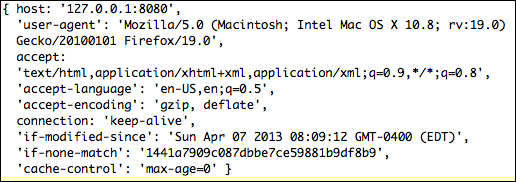Working with headers
Each HTTP request made to a Node server will likely contain useful header information, and clients normally expect to receive similar package information from a server. Node provides straightforward interfaces for reading and writing headers. We'll briefly go over those simple interfaces, clarifying some details. Finally, we'll discuss how to more advanced header usage might be implemented in Node, studying some common network responsibilities a Node server will likely need to accommodate.
A typical request header will look something like the following:

Headers are simple Key/Value pairs. Request keys are always lowercased. You may use any case format when setting response keys.
Reading headers is straightforward. Read header information by examining the request.header object, which is a 1:1 mapping of the header's Key/Value pairs. To fetch the "accept" header from the previous example, simply read request.headers.accept.
Tip
The number of incoming headers can be limited...
























































